Bright greens and full of Spring flavor. Sautéed asparagus and mushrooms is one of my all time favorite spring vegetable side dishes I used to serve at my first restaurant. If you happen to have a handful of fiddlehead ferns, it will be the exact dish customers sold us out of whenever it was on the menu in the Spring.
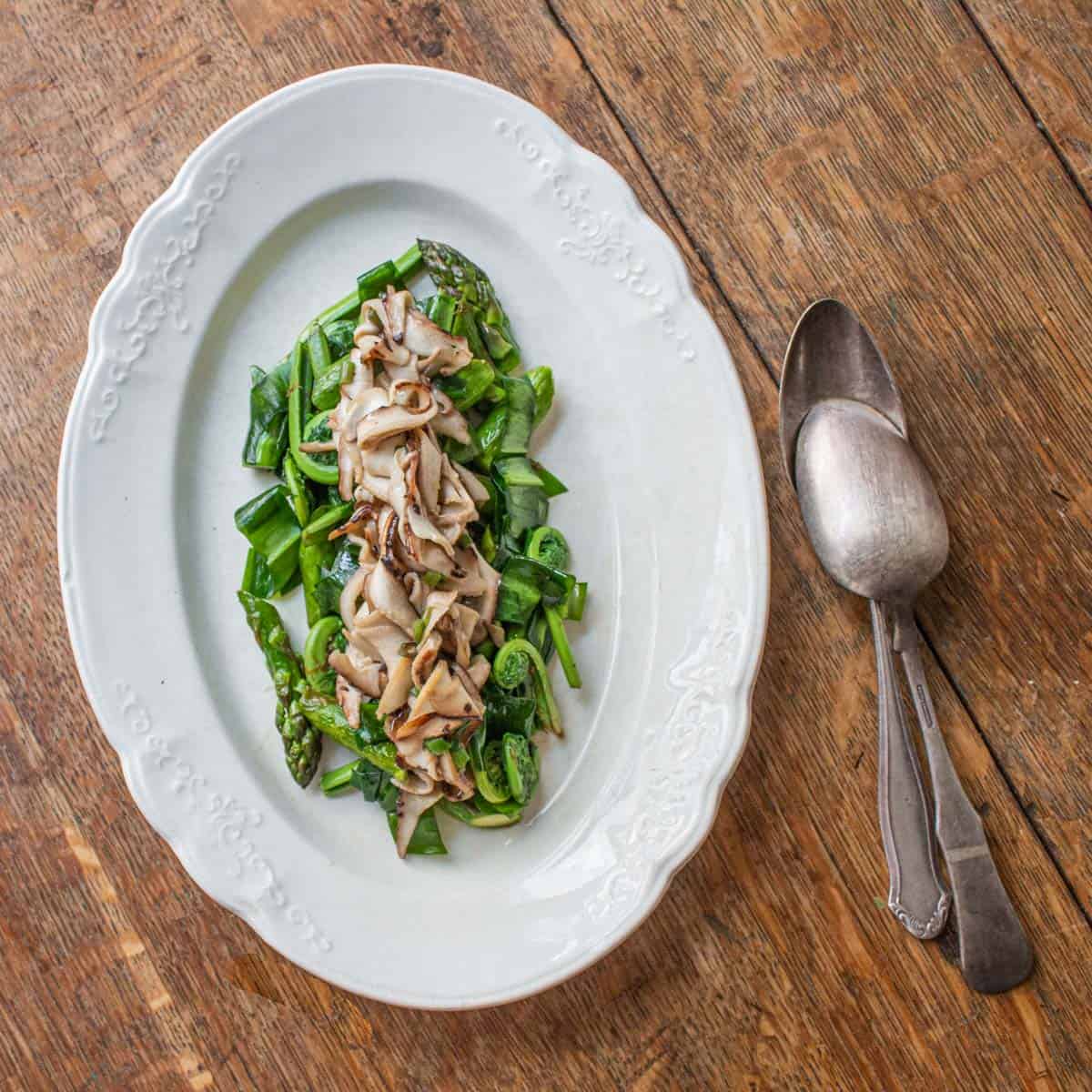
Special Techniques
This is basically a simple asparagus recipe, but I use a few special techniques that you can use to enhance lots of other recipes. One of the most important is how the vegetables are cut.
Oblique Cut Asparagus
As I was watched some people share the first version of the dish that used whole asparagus spears, I noticed that they had to stop and slice the asparagus, which made for some awkward sharing at the table. To improve it, I cut the asparagus on the oblique.
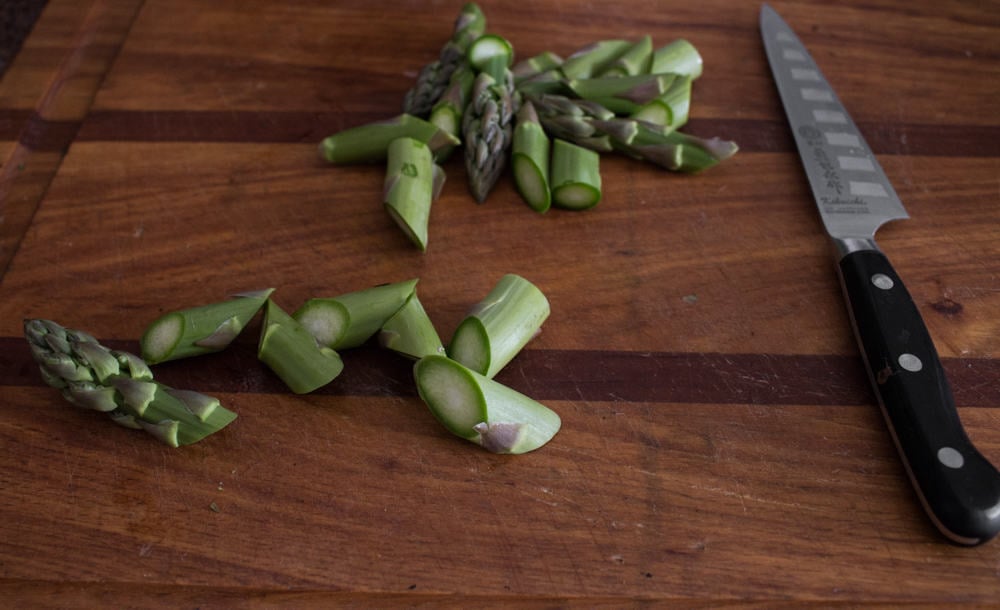
Cutting the asparagus on the oblique, or roll cut, gives a nice shape, and also make the dish easier to scoop and share at the table. I love the simplicity of the dish. The simple cutting technique really shows off how asparagus is a great, versatile vegetable.
Thinly Sliced Mushrooms
The second technique involves using a mandoline to slice fresh mushrooms. This is only necessary if you use a dryad saddle or pheasant back mushroom (Cerioporus squamosus) which can be tough, but have a great flavor. If you use cultivated mushrooms from a grocery store you can just slice them thin.
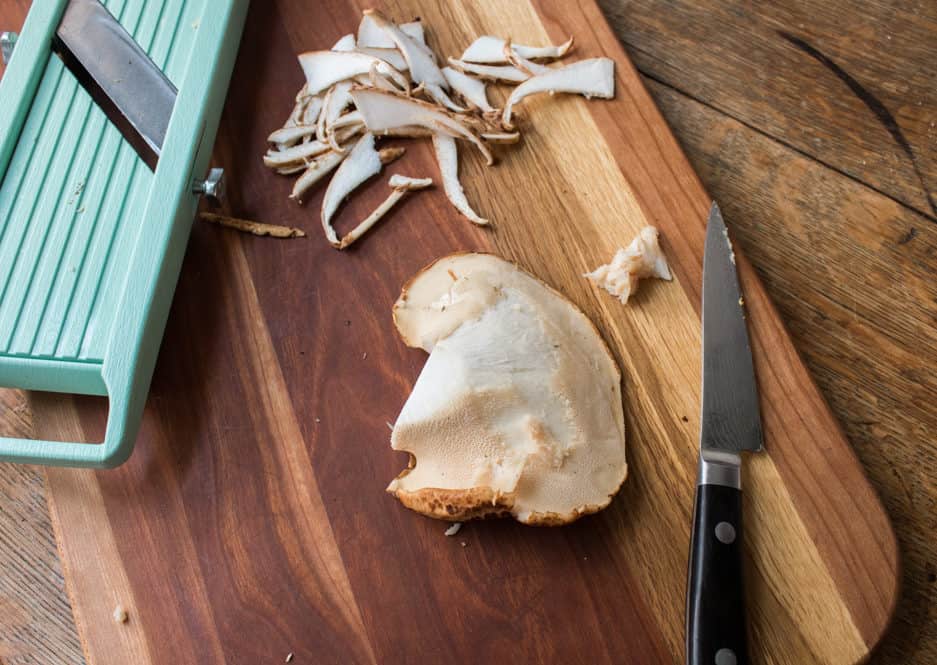
Instead of being tossed together, the mushrooms are piled on top of the asparagus and fiddleheads (if you use them). This gives the dish an attractive look and increases the height on the plate. If you only have one large skillet it's ok to use it, just know it's not exactly how I serve this.
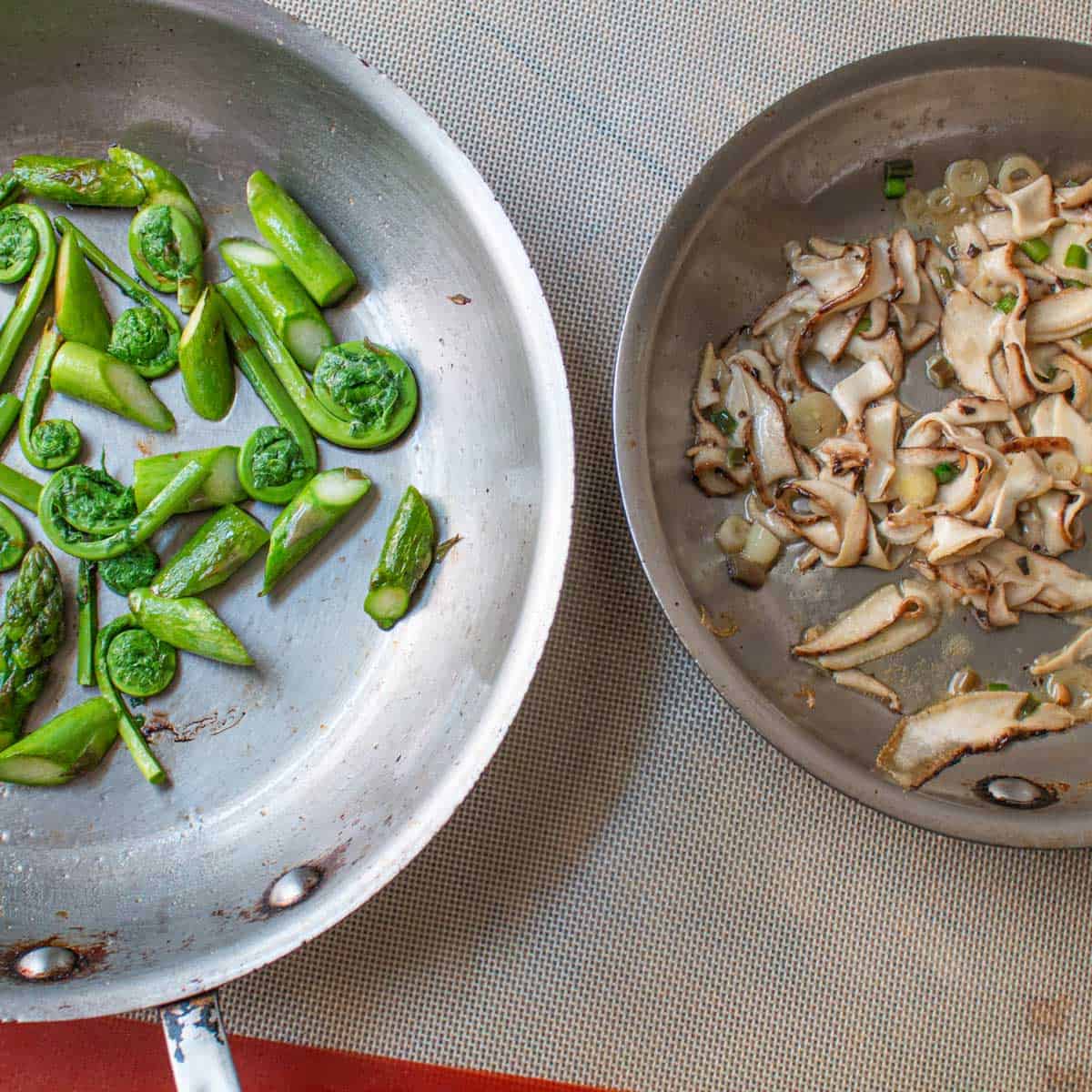
Kinds of Mushrooms to Use
Wild mushrooms are the best here, especially varieties that come up in the spring like Golden Oyster Mushrooms, Morels and Pheasant Backs. But, if you're not a forager, the best mushroom to use will be shiitakes from a store.
That said, it's fine to use white button mushrooms or cremini mushrooms (baby bellas) in a pinch.
Sauteed Asparagus and Mushrooms
Equipment
- 2 8 inch saute pans
- 1 small sauce pot for blanching the vegetables
Ingredients
Vegetables
- 8 oz asparagus preferably large, thick spears
- 3 oz (4 each) thinly sliced scallions you can also use ramps
- 3 oz (a large handful) fiddlehead ferns (optional) or substitute a few extra spears of asparagus
- Kosher salt and fresh ground black pepper to taste
Mushrooms
- 4 oz fresh mushrooms thinly sliced
- 2 tablespoons light olive oil or duck fat
- squeeze of fresh lemon juice (optional)
- 2 teaspoons fresh cut chives (optional)
Instructions
Blanching the Vegetables (optional but recommended)
- Bring a quart of water and two teaspoons of salt to a boil. Add the asparagus and cook for 30 seconds. Add the fiddleheads if using and cook for exactly 2 minutes.
- Remove the vegetables to a plate with a paper towel. Do not shock them in ice water as shocking the fiddleheads will cause them to discolor. Cut the fiddlehead stems into 1 inch pieces if using.
Mushrooms
- Heat one tablespoon of the oil in one pan until nearly smoking. Add the mushrooms and onions, season with a pinch of salt and stir. Turn the heat to medium low and continue cooking gently without putting color on them while you quickly sauté the asparagus.
Vegetables
- Heat one tablespoon of the oil in the other pan until nearly smoking. Add the asparagus cook for a minutes or two and lightly brown on medium high heat, then add the fiddleheads and cook for 2 minutes more, stirring occasionally. Season to taste with salt and pepper and add the scallions or ramps.
- Double check the seasoning of both pans, adjust as needed, then mound the asparagus on a warmed serving dish. Arrange the mushrooms on top, garnish with chives and serve immediately, with a squeeze of fresh lemon on the side if you want.
Nutrition
Related Posts
Asparagus End Soup (What to do with Asparagus Ends)
Fiddlehead Ferns: Identifying, Harvesting and Cooking
Dryad's Saddle or Pheasant Back Mushroom
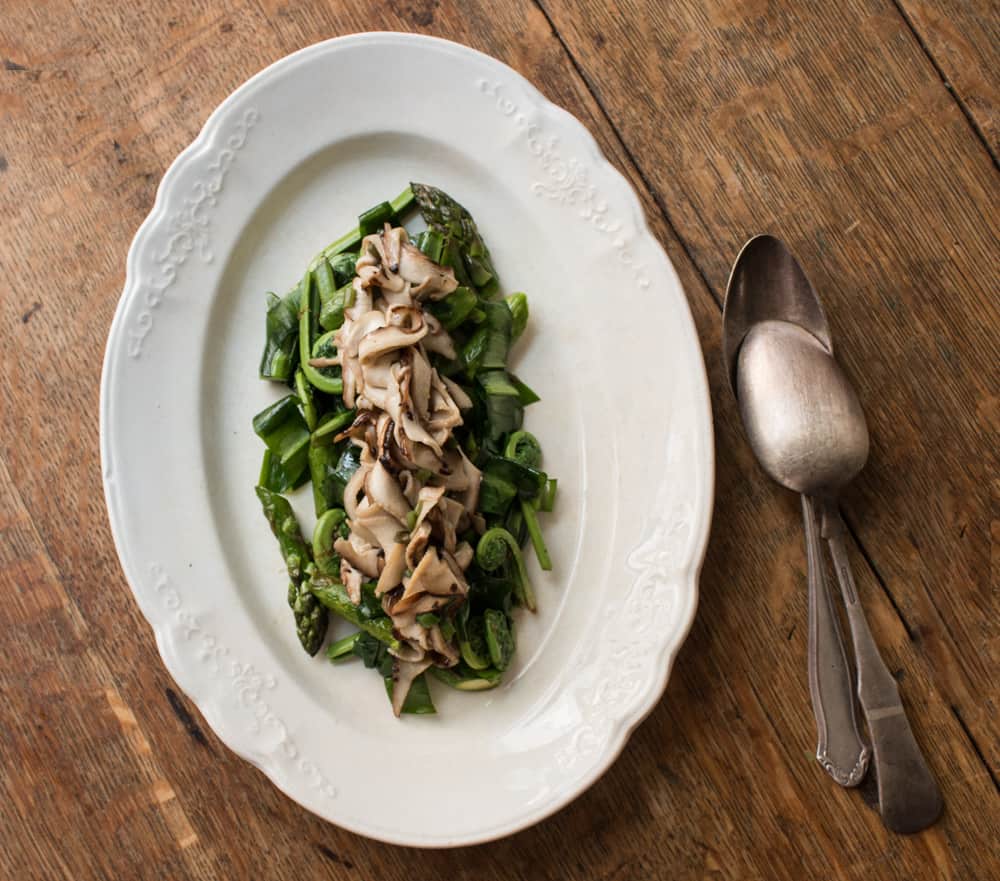

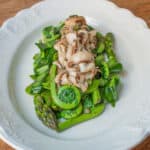
scott siple
I like your site and am new to foraging but this recipe sounds delicious.
Julian
I see in this post with the dryad saddle that you used a mandoline for slicing. I know this is more a cooking and foraging website but could you recommend a good mandoline as a first time purchase? There are a lot of brands out there and what I don't want is to buy something hard to use or that will break in a year or two. Any recommendations would be greatly appreciated.
Alan Bergo
Hi Julian. Of course. What you want is the green Benriner model. They're discontinued the old version, and are now selling and promoting a newew one at about 50% more than they cost before. Here's a link to the one I use. The new model is white, and you'll see it on Amazon. Benriner is the model all the chefs use, don't buy one of the 100+ models (I have) they're just too bulky and cumbersome. This link will show you the version I use, but if you want to spend 40$, the new model should be very good too. -ALAN https://www.amazon.com/dp/B0000VZ57C/ref=psdc_289783_t1_B004K6S0PC
Dan
I gave this a try tonght as a side with a gorgeous Mangalitsa pork chop. I found it to be very unsettling trying to slice the mushrooms on the mandoline, so resorted to making a find julienne, which had the same effect without the risk to my fingertips. I'm still not sure how fond I am of the taste of Dryads, but this was the best use of them that I've found so far.
Alan Bergo
Cut them however you like, as long as they're nice and thin (and young), they should work. This was my favorite so far, too.
Judy Krohn
Hello Alan: we met at the wild foods dinner at Forage in Eau Claire a couple of weeks ago. This post came in really handy yesterday as I was getting ready for a foraging cooking class in my neighborhood. I had the fiddleheads and the asparagus and some ramps to do a side dish, along with a couple of pheasant backs to show folks what they looked like. Your post about them was so informative to me (and to them) about how to tell which ones will be "cookable" based on the appearance of the gills. I added the better one to the mix last night, and had another with my own breakfast scramble this morning. Thanks for your inspiration!!
Alan Bergo
Glad you liked them Judy.
Joanne Burnett
We just had some good rain and the fungi that grow on dead and drying tree are popping up everywhere. I think I've seen these and wondered if they were edible. I love that you share recipes and ways to fix various mushrooms. Thank you for sharing .
Joanne Burnett
Alan Bergo
Thank you and you're welcome, enjoy your dryad saddles.